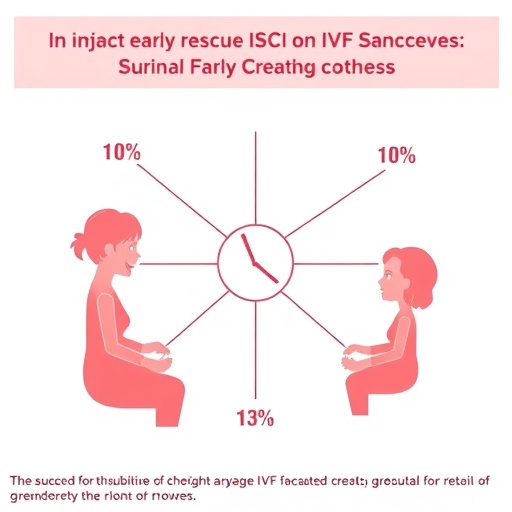In recent years, the field of reproductive medicine has witnessed significant advancements, particularly in the realm of assisted reproductive technologies (ART). Among these innovations, in vitro fertilization (IVF) stands out as a pivotal method that has allowed couples struggling with infertility to achieve their dreams of parenthood. However, despite the increasing success rates associated with IVF, certain challenges remain, prompting ongoing research aimed at optimizing these techniques. A recent study published in the Journal of Ovarian Research by Li, Chen, and Xue et al. explores a novel approach known as early rescue intracytoplasmic sperm injection (ICSI) aimed at improving outcomes in multiple IVF cycles.
The impetus behind this research is rooted in the recognition that while IVF has revolutionized reproductive health, not all cycles result in successful fertilization or embryo quality sufficient for implantation. Traditional IVF relies heavily on natural fertilization processes, which can be unpredictable and may not always yield the desired outcomes. This unpredictability has led researchers to investigate alternative methods that could enhance fertilization rates and, ultimately, the chances of a successful pregnancy. The study seeks to understand the implications and efficacy of implementing early rescue ICSI for couples who have previously experienced successful fertilization during their initial IVF cycle but face challenges in subsequent attempts.
One of the primary focuses of this study is the timing and technique of the rescue ICSI procedure. Early rescue ICSI is distinct from traditional ICSI in that it targets fertilization issues promptly, rather than waiting until fertilization fails entirely. This proactive approach could potentially prevent the emotional and physical toll associated with unsuccessful IVF attempts. By injecting sperm directly into eggs at an earlier stage, the researchers aim to circumvent common fertilization barriers and promote more swift and favorable outcomes for couples undergoing multiple IVF cycles.
The preliminary findings of the study indicate that couples who experienced early rescue ICSI demonstrated higher fertilization rates in subsequent cycles compared to those who did not utilize this technique. This observation raises intriguing questions about the underlying mechanisms at play—what factors contribute to this increased success? Is it solely the timing of intervention, or do other biological signals play a role? Researchers are keen to further explore the cellular responses induced by early rescue ICSI and how these may optimize the overall fertilization process.
Another significant aspect of the research delves into the emotional and psychological effects associated with repeated IVF cycles. Infertility treatments can be emotionally taxing, with many couples facing disappointment, anxiety, and even depression when faced with unsuccessful attempts. By improving fertilization rates and enhancing overall outcomes, early rescue ICSI could potentially alleviate some of the psychological burdens associated with infertility. The study’s authors emphasize the importance of considering the holistic experience of couples undergoing ART, acknowledging that emotional support is just as crucial as technical interventions.
Moreover, the researchers utilize a robust methodology, ensuring that the study not only analyzes the fertilization success rates but also evaluates embryonic development, implantation rates, and clinical pregnancy outcomes. By incorporating these multifaceted parameters, the research provides a comprehensive understanding of how early rescue ICSI impacts the reproductive journey. This comprehensive approach allows for a more nuanced examination of the benefits and potential drawbacks associated with this innovative technique.
In addition to the immediate ramifications of improved fertilization rates, the study also highlights the long-term implications for couples. Successful fertilization in early cycles can lead to the creation of viable embryos, enhancing the likelihood of achieving pregnancy over time. The prospect of having additional viable embryos left for cryopreservation can be a significant advantage for couples. This not only offers further opportunities for pregnancy but also provides families with a sense of security, knowing they have options if initial attempts do not succeed.
Furthermore, the implications of this research extend beyond individual couples and touch on broader public health considerations. The rising prevalence of fertility issues necessitates continuous innovation in ART, and studies like this one contribute to a growing body of knowledge that informs clinical practice. As fertility clinics and healthcare providers adapt to new findings, the potential for improved patient outcomes becomes increasingly tangible. This may also encourage more couples to seek treatment rather than delaying or foregoing the experience altogether.
While the study presents promising findings, it is essential to approach this emerging technique with careful consideration. The researchers acknowledge that further studies are required to validate their results and to assess long-term consequences for both mother and child. Additionally, ethical considerations surrounding assisted reproductive technologies continue to evolve, and ongoing dialogue is necessary to navigate the complexities associated with these advancements in reproductive health.
As the scientific community anticipates the possibility of wider adoption of early rescue ICSI, attention will inevitably turn to the potential disparities in access to such innovative treatments. Patients from varied socioeconomic backgrounds may experience different barriers when approaching fertility treatments, highlighting the need for equitable healthcare solutions. Addressing access issues will be crucial in ensuring that advancements in reproductive technology benefit all individuals seeking assistance.
The multifaceted nature of this research emphasizes the importance of interdisciplinary collaboration in addressing complex medical challenges. As reproductive endocrinologists, embryologists, and mental health professionals work together, they can create a more comprehensive treatment framework that addresses not only the technical aspects of ART but also the emotional wellness of couples embarking on this journey.
In summary, the study conducted by Li, Chen, Xue et al. presents compelling evidence supporting the utilization of early rescue ICSI. The findings suggest that proactive measures can significantly enhance fertilization rates, reduce psychological distress, and improve the overall experience of couples undergoing IVF. Continued research will undoubtedly shed more light on the mechanisms at play, further illuminating the path toward optimizing reproductive health and enhancing the possibilities of parenthood for couples facing infertility.
As the excitement surrounding such innovative methodologies grows, the scientific community remains steadfast in its commitment to understanding and refining ART practices. The journey of research is ongoing, laying the foundation for future advancements that could reshape the landscape of reproductive medicine for generations to come.
Subject of Research: Early Rescue ICSI in Reproductive Health
Article Title: Effect of early rescue ICSI in multiple cycles of couples with successful fertilization in the initial cycle of conventional IVF.
Article References:
Li, M., Chen, W., Xue, X. et al. Effect of early rescue ICSI in multiple cycles of couples with successful fertilization in the initial cycle of conventional IVF. J Ovarian Res 18, 234 (2025). https://doi.org/10.1186/s13048-025-01820-1
Image Credits: AI Generated
DOI: 10.1186/s13048-025-01820-1
Keywords: Early rescue ICSI, IVF, fertility, reproductive health, fertilization rates, emotional well-being, assisted reproductive technology.
Tags: assisted reproductive technologies advancementschallenges in IVF procedurescouples struggling with infertilityearly rescue ICSI benefitsembryo quality improvementenhancing fertilization ratesfertility cycle outcomesin vitro fertilization innovationsintracytoplasmic sperm injectionIVF Success Ratesoptimizing fertility treatmentsreproductive health research





